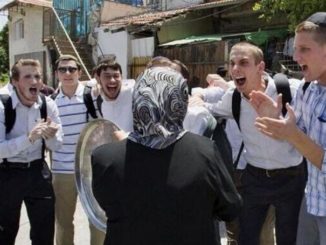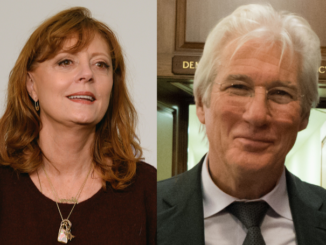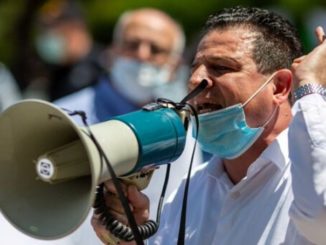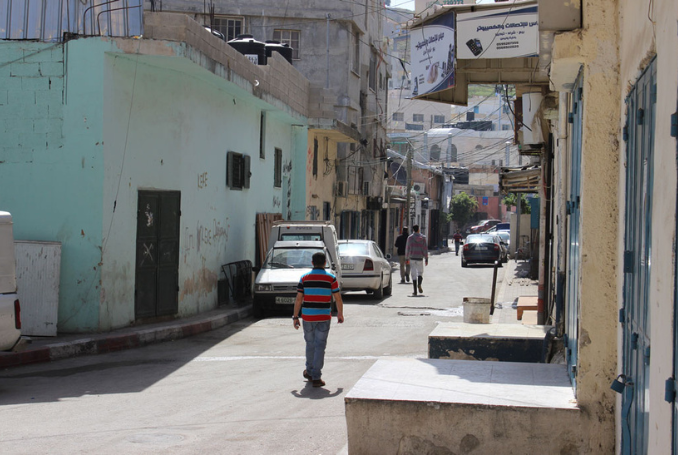
Khairiya Ahmed, 80, sits on the doorstep of her house in Al-Arroub camp, north of Hebron (Al-Khalil), in the occupied West Bank. She leans on her crutches and contemplates the life she has lived for more than 75 years.
In 1948, this elderly woman was living with her family of nine in Ajjur, a Palestinian village located northwest of Hebron that was depopulated by Zionist militias 75 years ago. Its Palestinian inhabitants are now refugees, living in Palestine and in exile.
At that time, Khairiya was only five years old. She doesn’t remember much of what happened then, but she knows that terrible things drove her family and all the villagers out of Ajjur at gunpoint.
“I remember the complete darkness and the voices of my parents screaming and trying to protect their seven children,” Khairiya told The Palestine Chronicle.
“My older brother was fourteen years old at the time. He was helping my father gather us and put us in a safe place before the hands of the Zionist raiders could reach us.”
The Ahmed family left their home in the once-peaceful village, just like hundreds of thousands of Palestinians who were forcibly displaced from their homes by Israel.
For Palestinians, that process of ethnic cleansing is known as the Nakba, the catastrophic destruction of historic Palestine.
The displaced families were keen on preserving the keys to their homes and their important documents proving the ownership of their homeland.
Sadly, the rusty keys remain in their possession to this day in a place far from home.
Khairiya’s father was crying fervently after he left his village, Ajjur. As a curious little girl, Khairiya asked him about the reason for his tears. His response was that he was living on a piece of paradise, and he was forced to move to a mere box of bricks, under Israeli military occupation and daily oppression.
Tents and Stone Houses
To cope with the consequences of that disastrous displacement, the United Nations created the UN Relief and Works Agency for Palestinian Refugees (UNRWA). They were tasked with building temporary refugee camps for Palestinians who sought refuge in other areas within Palestine, which were less vulnerable to Israeli attack.
These camps extended from Jenin, in the northern West Bank, to Hebron in the south. They are still standing today. The temporary tents have, over time, turned into small stone houses.
Those masses of dispossessed refugees have lived under harsh conditions for 75 years, without anyone paying serious attention to their misery or helping them return to their original homes in their stolen homeland.
Following the Nakba, nineteen camps were established in the occupied West Bank. With the signing of the Oslo agreement, they were divided between areas A, B, and C. The largest of them, in terms of population, is the Balata refugee camp in the city of Nablus.
This is Not Life
Living in a refugee camp is not easy.
Fadl al-Ramahi, 56, lives in Al-Jalazone camp, north of Ramallah. He was brought up with the hope of returning to his original village, Al-Muzayri’a, in the district of Ramla, despite being born twenty years after the Nakba.
“To live in the camp means to endure harsh living conditions and continued distress,” Fadl told us. “The houses here are so crowded, when you open a window, you find the window of another house. The streets are narrow, barely enough for a car.”
In each camp, a popular committee was formed from residents themselves, under the supervision of UNRWA to follow up on the needs of each camp. However, living conditions hardly change. They often worsen due to the growing population of the overcrowded camps.
The camp infrastructure is very poor. Alleys are barely paved and sewage drainage is weak. Rubbish is everywhere.
In addition, Israel does not allow the refugees to live their life, however imperfect. Almost daily, the Israeli army carries out incursions, assaults, arrests, and even the killing of their residents.
If the camps are located near settlements, Israeli forces often close their entrances to ensure protection for the illegal Jewish settlers.
“I imagined our small village whenever my father talked about it. He dreamed of going back to Al-Muzayri’a or just seeing it from afar one last time. Sadly, he died before fulfilling his dream,” Fadl said.
“He always told us about his memories there, the crops he used to grow and our two-floor house. Now we live in a small house. We had to accept anything after we were expelled from our villages.”
To this day, the Palestinian refugees refuse to say that they belong to these camps. Just mention the names of their abandoned villages and you will see, in their eyes, the fervent hope of returning to their land.
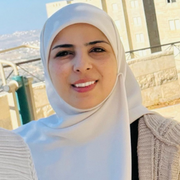
– Fayha’ Shalash is a Ramallah-based Palestinian journalist. She graduated from Birzeit University in 2008 and she has been working as a reporter and broadcaster ever since. Her articles appeared in several online publications. She contributed this article to The Palestine Chronicle.



